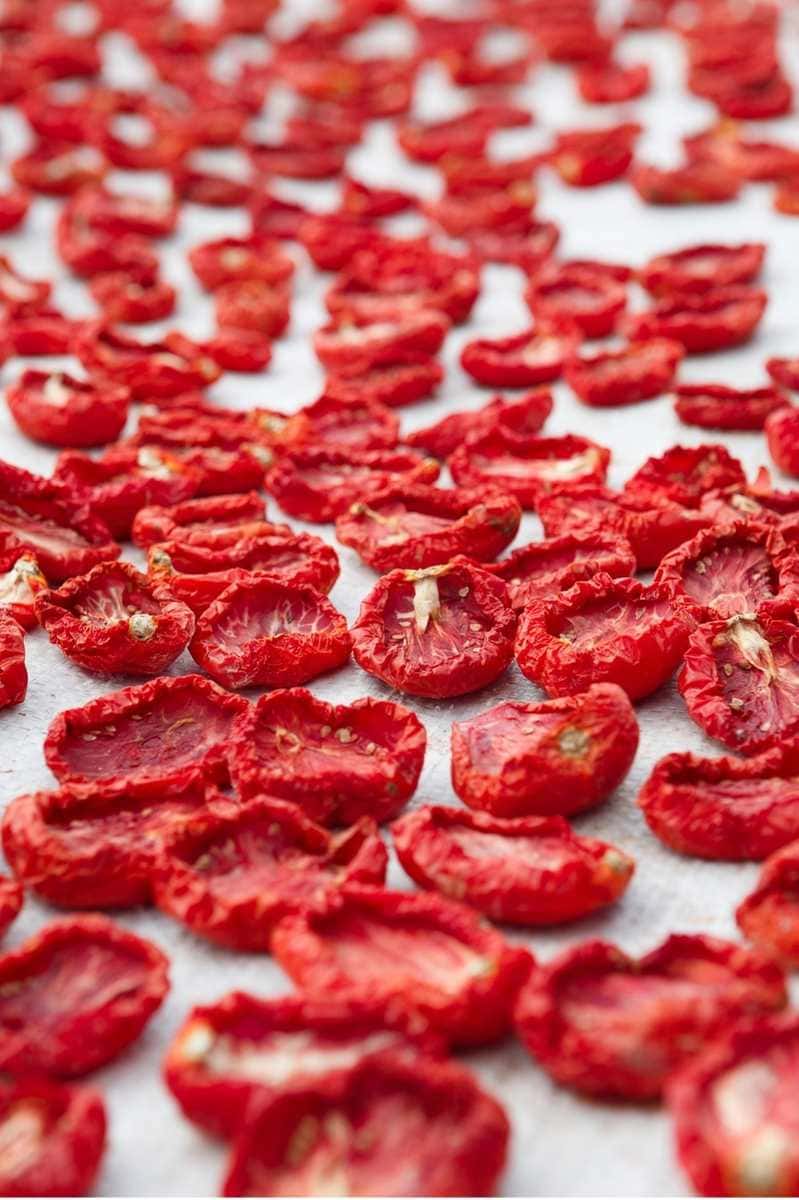While you know we love canning and freezing, there’s a hidden preserving gem that will allow you to enjoy the fresh flavor of summer throughout the long winter months—dehydrating! Dehydrating is an easy way to preserve your tomato harvest, and there’s very little prep work. You just slice your clean tomatoes and begin dehydrating.
There are several methods for dehydrating tomatoes, and for most of them, you don’t need any fancy equipment to get started. All you need is a little patience and a whole lot of tomatoes! Your oven, a dehydrator, or even the power of the sun can turn fresh, juicy tomatoes into sweet, compact treats.
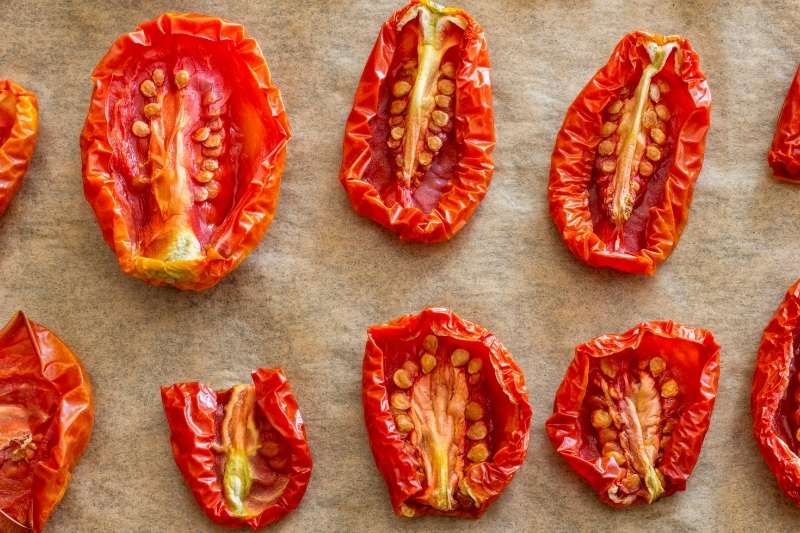
What type of tomato is best for dehydrating?
Any tomato can be dehydrated, whether it’s a firm paste tomato, a juicy beefsteak, or a sweet cherry tomato. This makes dehydrating tomatoes easy because you can use any tomato that you have on hand. That being said, there are some subtle differences between them.
Cherry, grape, and beefsteak tomatoes aren’t canned or frozen as often because of their watery texture and abundance of seeds. So if you have an abundance of these tomatoes, dehydrating them makes a lot of sense.
You’re probably using your plum tomatoes, such as romas, in sauces and canning recipes. But if you do choose to dry roma tomatoes, their meaty flesh allows them to dry slightly faster than slicing and cherry tomatoes.
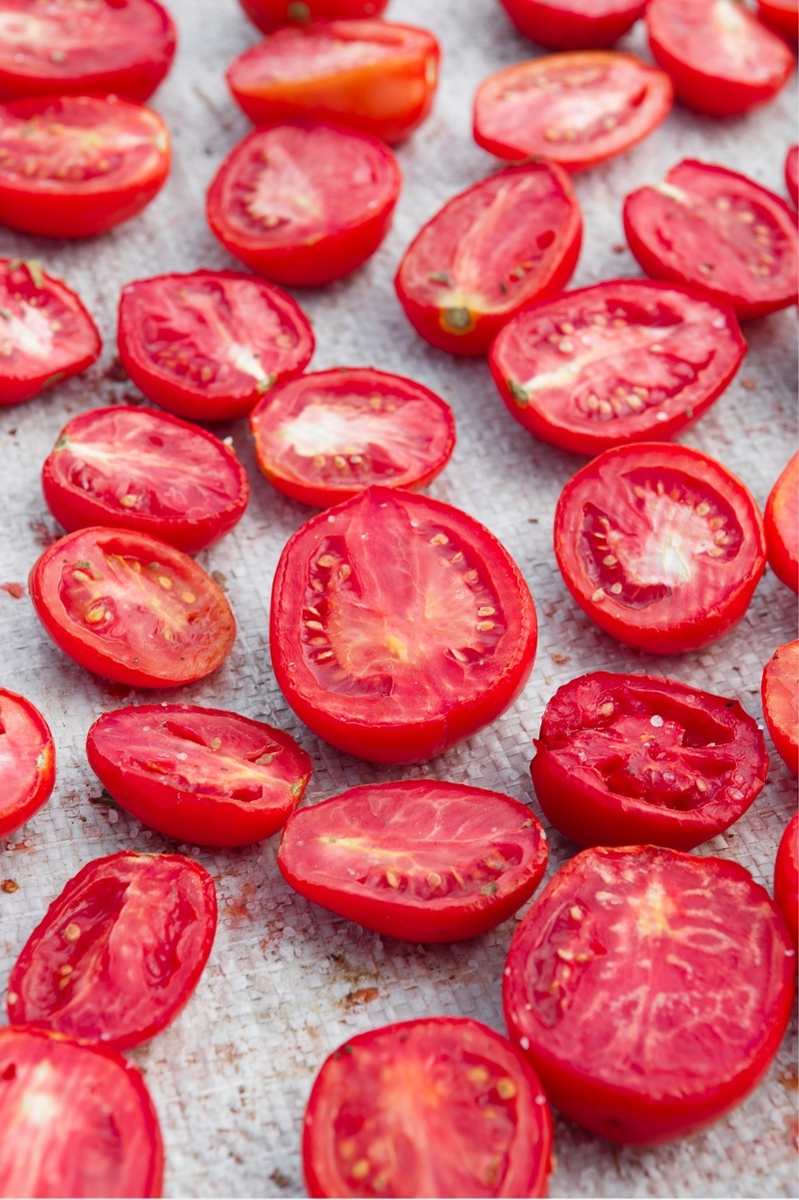
Is there one dehydrating method that’s better than others for dehydrating tomatoes?
All three methods work well, but not every technique will work for every person.
Sun-dried tomatoes need several days of warm, low-humidity weather to properly dry. Too much humidity in the air can cause your tomatoes to mold. If you don’t live in an arid climate, using the sun to dry tomatoes might not work for you. It’s also the hardest method to control—we have zero control over the weather—so if you’re new to dehydrating, you might want to practice with the oven or dehydrator method first.
Dehydrating tomatoes in a dehydrator is probably the easiest method for beginners, since you control the temperature, and you just set it and forget it. There’s also a steady flow of warm air around all of your tomatoes, so you’re going to get evenly dried slices in the end.
However, not everyone has a dehydrator handy, so if you don’t want to invest in any equipment, you can use your oven for dehydrating tomatoes. The results will still be delicious!
Oven drying isn’t as easy as using a dehydrator, but it’s still fairly simple. It’s worth noting that some ovens don’t go as low as 160°F. If you’re in this situation, you’ll have to pay more attention to your tomatoes by checking on them often. This way, you can be sure they’re not overly dried out, which can cause them to blacken and become too crispy.
Tell me about dehydrating tomatoes in the oven!
Oven drying is the most accessible method for dehydrating tomatoes—you don’t need any special equipment, and you don’t have to worry about the weather. To dry tomatoes in the oven:
- Set your oven to 160°F. If your oven can’t run that low, set it to the lowest possible temperature.
- Cut your tomatoes and spread them in a single layer on a wire baking rack set inside a rimmed baking sheet.
- Bake at a low temperature in the oven for several hours, until the tomatoes are dry but pliable. If drying at a temperature higher than 160ºF, check the tomatoes often for burning, making sure to rotate the pans regularly.
Wholefully Protip
If you’re drying multiple trays of tomatoes, you might want to prop open your oven door a bit to allow steam to escape.
What about dehydrating tomatoes in a dehydrator?
Using a food dehydrator is the easiest way to dry tomatoes—it is the most hands-off and least finicky method. All you have to do is:
- Cut your tomatoes into evenly sized pieces, and spread them in a single layer on dehydrator trays.
- Dry the tomatoes in the dehydrator at 140°F until they are dried but still pliable.
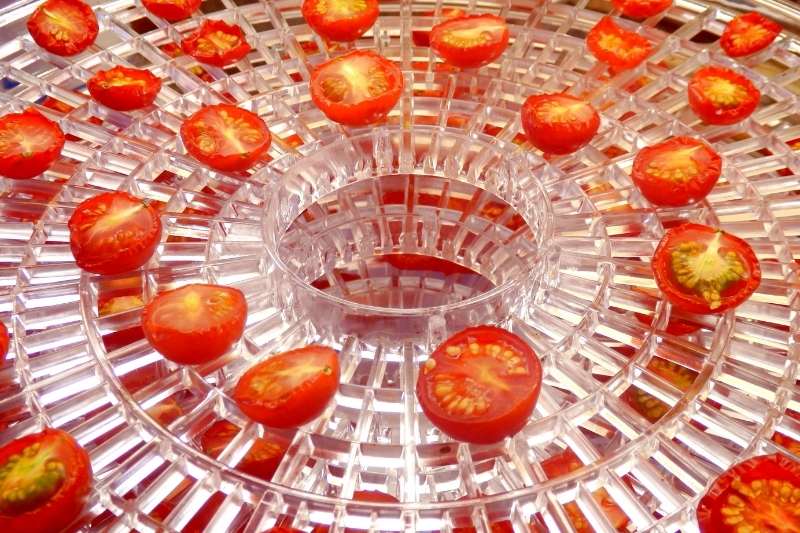
What is the best food dehydrator?
There are a lot of really expensive food dehydrators out there that do great work, but we’ve used this very affordable Nesco Snackmaster Food Dehyradtor for years with excellent results. It’ll set you back less than $100, and you can expand it to hold up to 12 trays—meaning you can dehydrate over 13 square feet of produce at a time! That’s a lot of tomatoes!
How do I make sun dried tomatoes?
Sun dried tomatoes have a beautiful rich, complex flavor, but your weather has to be just right. The air needs to be relatively dry and warm, and you need a few sunny days on top of that. If your weather is right though, you can make sun dried tomatoes!
- Cut tomatoes into evenly-sized pieces. Spread them in a single layer on a baking rack set inside a rimmed baking sheet.
- Place the tomatoes in the sun, in a spot where they will get plenty of air circulation and are away from pests. We often cover ours with insect netting to keep bugs out.
- The tomatoes are done when they are dry but pliable, which can take several hours up to several days to achieve.
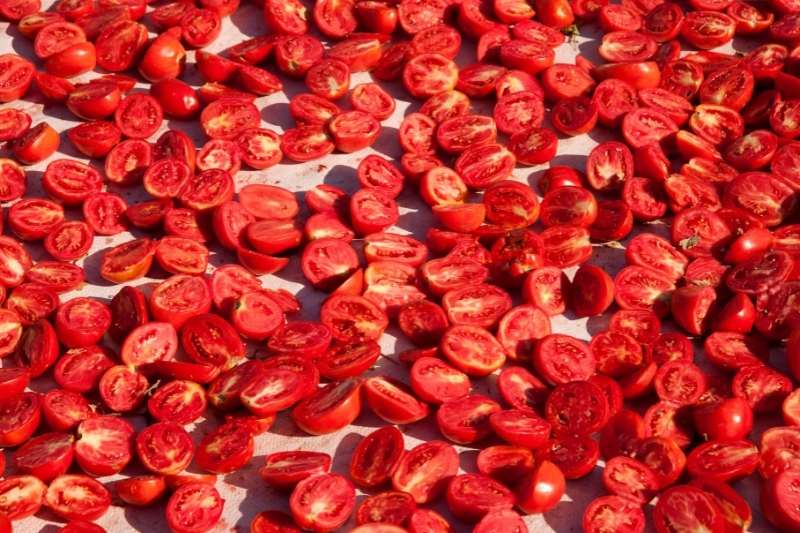
How do I know when my tomatoes are done?
Your tomatoes are finished when they are dry, but still flexible. Over-dried tomatoes will be brittle and tough. Make sure the tomatoes do not feel soft or moist. If tomatoes aren’t dried long enough they will spoil quickly.
Can I cut my tomatoes thinner to speed up drying time?
Nope, sorry—patience is the key to properly dehydrating tomatoes. Shortcuts and dehydrating tomatoes don’t mesh well. If you cut your tomatoes thinner than ½ inch, you run the risk of your tomatoes becoming overly brittle and dry and mostly unusable.
For best results, stick to the slicing recommendations in the recipe below and make sure that your slices are all roughly the same thickness.

Can I increase the temperature to speed up the dehydrating time?
Once again, patience is key. It takes time and a steady low heat source for delicious dehydrated tomatoes. The water in your tomatoes needs to slowly evaporate—not steam the tomatoes into a goopy mess.
If the temperature is too high, you risk burning or steaming your tomatoes instead of dehydrating them. If tomatoes are dehydrated at too high of a temperature, you risk the middle remaining moist while the outside hardens, which is a recipe for mold.
How can I use my dehydrated tomatoes?
Dehydrated tomatoes are great as toppers on salads, pizzas, and sandwiches, or mixed into spreads. They make tasty additions to soups, stews, and other dishes where they’ll absorb the liquid around them, plumping them up and re-hydrating them. You can also toss them into your casseroles, omelets, and pasta salads for a burst of fresh tomato flavor. They’re also pretty tasty on their own as a snack. The sky’s the limit for these compact dry tomatoes!
Wholefully Protip
Dry at least one batch of your tomatoes until they are brittle dry. Then, once completely cooled, grind them in a coffee grinder. You just made tomato powder! Mix with a little water, and you have instant tomato paste. You’ll never need to buy those little cans or tubes again!
How do I rehydrate the tomatoes?
Soak tomatoes in boiling water for about 10 minutes. Remove with a slotted spoon and pat dry before using.
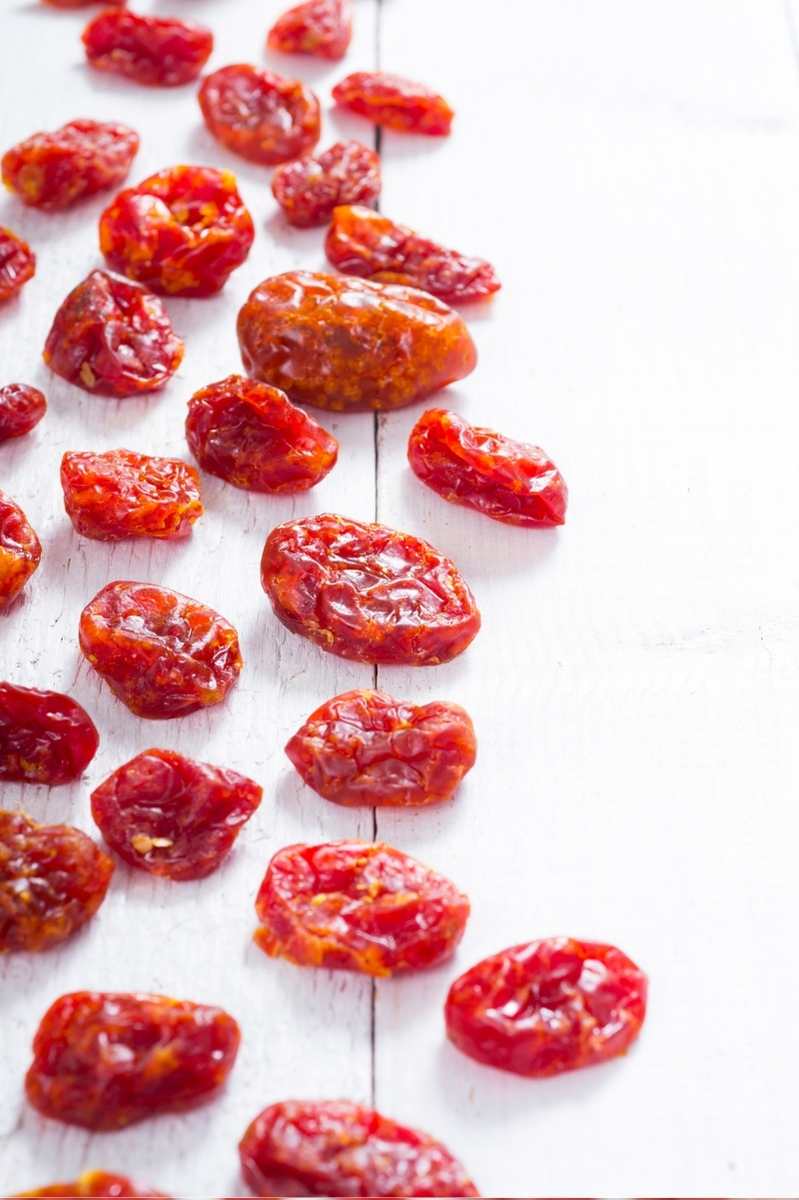
How long will dehydrated tomatoes last?
Properly stored, dehydrated tomatoes should last at least six months at room temperature. When stored in the fridge or the freezer, you can stretch that time to a year.
When you open your tomatoes, check that there’s no mold before eating them. Dehydrated tomatoes that have gone bad often have an unpleasant smell, and they’ll taste stale.
What’s the best way to store your tomatoes after they’ve been dehydrated?
Canning jars are perfect for dehydrated tomatoes storage because they’re airtight. You can use any airtight container as long as it’s completely dry on the inside. Your container should be stored in a cool, dry location that’s out of direct light.
You can also store your tomatoes in the fridge or freezer if you want to safely extend the life of the tomatoes.
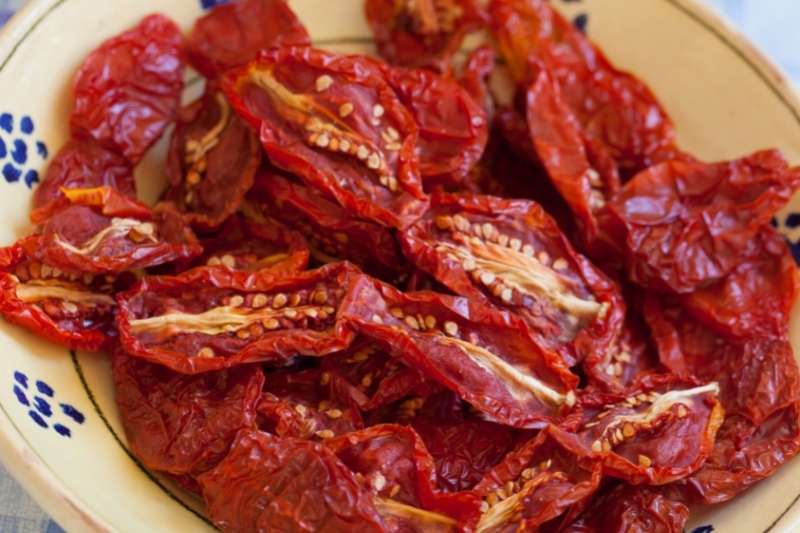
Do I need to remove the seeds and skin of my tomatoes?
Nope! The skin of the tomato contains added nutrients, and it can help your slices hold their shape during the dehydrating process. The seeds also contain beneficial nutrients, so you don’t have to remove them. When you re-hydrate your tomatoes, the skins tend to separate and float to the surface of the soup or water, making them easy to skim out if you’d like.

How to Dehydrate Tomatoes
Dehydrating tomatoes is an easy way to preserve them, and there are three ways to do it. Read our guide to learn how.
Ingredients
- 3 pounds fresh tomatoes
Instructions
Dehydrator
- Cut tomatoes into evenly sized pieces. For large tomatoes, quarter them. For medium, small, or cherry tomatoes, cut them into halves.
- Place the tomatoes in a single layer on dehydrator trays.
- Dry the tomatoes in the dehydrator at 140°F. It will take several hours for the tomatoes to dry, and the exact time will depend on the size of your tomatoes, the humidity in the air, and other considerations.
- Your tomatoes are finished when they are dry, but still pliable. Over-dried tomatoes will be brittle and tough. If tomatoes aren’t dried long enough they will spoil quickly. Make sure the tomatoes do not feel soft or moist.
Oven-Dried
- Preheat your oven to 160°F. If your oven doesn’t go that low, preheat it to as low as it will go, but know that you’ll need to keep a close eye on your tomatoes to prevent burning.
- Cut tomatoes into evenly sized pieces. For large tomatoes, quarter them. For medium, small, or cherry tomatoes, cut them into halves.
- Place a baking rack inside a rimmed baking sheet. Place the tomatoes in a single layer on the baking rack.
- Dry the tomatoes in the oven. It can help to flip your tomatoes over halfway through the drying process. If you have a few trays of tomatoes in your oven, crack the oven door to allow for better circulation.
- It will take several hours for the tomatoes to dry, and the exact time will depend on the size of your tomatoes, the humidity in the air, and other considerations.
- Your tomatoes are finished when they are dry, but still pliable. Over-dried tomatoes will be brittle and tough. If tomatoes aren’t dried long enough they will spoil quickly. Make sure the tomatoes do not feel soft or moist.
Sun-Dried
- Sun dry tomatoes only when warm, dry, sunny weather is expected for several days. If you live in a high-humidity region, sun-drying may not be right for you.
- Cut tomatoes into evenly sized pieces. For large tomatoes, quarter them. For medium, small, or cherry tomatoes, cut them into halves.
- Place a baking rack inside a rimmed baking sheet or use large screens set up outside for circulation. Place the tomatoes in a single layer on the baking rack or screens.
- Place the tomatoes in a sunny spot with good circulation, away from where critters can get to them. You may want to cover your tomatoes with insect netting to prevent insects from getting into them.
- It will take several hours to days for the tomatoes to dry, and the exact time will depend on the size of your tomatoes, the humidity in the air, and other considerations.
- Your tomatoes are finished when they are dry, but still pliable. Over-dried tomatoes will be brittle and tough. If tomatoes aren’t dried long enough they will spoil quickly. Make sure the tomatoes do not feel soft or moist.
Nutrition Information:
Yield: 3 Serving Size: 1 ozAmount Per Serving: Calories: 82Total Fat: 1gSaturated Fat: 0gTrans Fat: 0gUnsaturated Fat: 1gCholesterol: 0mgSodium: 23mgCarbohydrates: 18gFiber: 5gSugar: 12gProtein: 4g
At Wholefully, we believe that good nutrition is about much more than just the numbers on the nutrition facts panel. Please use the above information as only a small part of what helps you decide what foods are nourishing for you.

